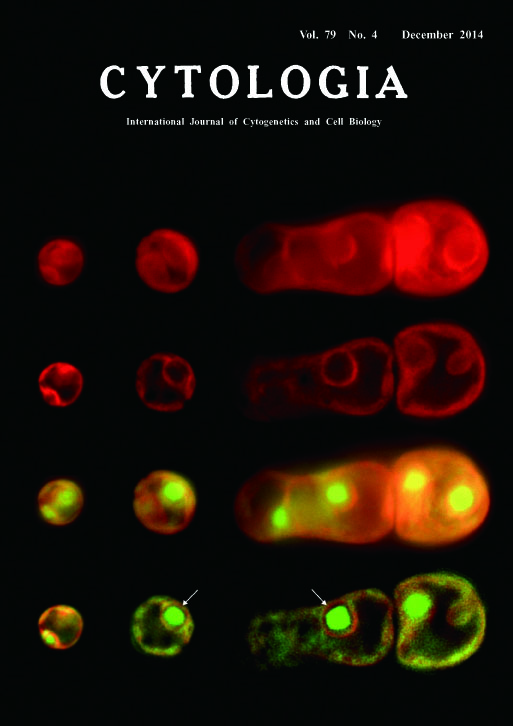| ON THE COVER |  |
|
|---|---|---|
| Vol. 79 No.4 December 2014 | ||
| Technical note | ||
|
|
||
| A Transformation System Using rbcS N-Terminal Region Fused with GFP Demonstrates
Pyrenoid Targeting of the Small Subunit of RubisCO in Ulva compressa Ryogo Suzuki1, Tomokazu Yamazaki1, Atsushi Toyoda2 and Shigeyuki Kawano1* Ulva compressa is a macro green alga, the life cycle of which alternates between haploid generation and diploid generation or repeats the haploid generation with parthenogenesis of the gametes. U. compressa is used as a model organism of macro green algae, and its genome sequence is under analysis. The establishment of a transformation system for U. compressa would provide advantages for the characterization of interesting genes isolated from the genome, such as the male-specific HAP2/GCS1 involved in conjugation (Yamazaki et al. 2014). However, a transient transformation method that can consistently accomplish 1% gene expression frequency has not been reported for macro green algae. Here, we report PEG-mediated transient gene expression of U. compressa gametes that lack cell wall structure. The PEG (polyethylene glycol) method for algae is reported in Cyanidioschyzon merolae, which also does not have a rigid cell wall structure (Ohnuma et al. 2008). U. compressa gametes were concentrated using positive phototaxis. After adding 150 μL of artificial seawater containing 10 μg of plasmid DNA to 100 μL of gamete suspension, 250 μL of PEG solution was added to the mixture to yield a final PEG concentration of 30%. The gamete suspension was added to artificial seawater in a sixwell plate. A cover slip was placed at the bottom of the well. U. compressa on the cover slip was observed using fluorescence microscopy. Gene expression frequencies were 9?15% with high reproducibility in four repeated experiments.. Small subunits of the RubisCO (rbcS) structure are important in the formation of pyrenoids, which are contained in the chloroplast of almost eukaryotic algae. We isolated the rbcS nucleotide sequence from the U. compressa genome data to obtain a chloroplasttargeting sequence and fused it to the GFP gene. The cover image shows a fluorescence image of U. compressa cells in parthenogenesis. The small one-cell phase (left), the large one-cell phase (middle) after the cell diameter increase, and the two-cell phase (right) are shown. In the first row, the chloroplast shape and position were observed based on chlorophyll autofluorescence (red). In the second row, a deconvoluted optical section of the first row is shown. In the third row, merged images of the chloroplast targeting GFP fluorescence (green) and chlorophyll autofluorescence are shown and the fourth row shows an optical section of the third row. They show yellow-colored chloroplast because two fluorescence images are almost overlapped. GFP fluorescence signal was specifically observed in the pyrenoid section (arrows).
Yamazaki, T., Endo, M., Ito, K., Suzuki, R., Ota, S., Kuwano K., Miyamura, S., Toyoda, A. and Kawano, S. 2014. HAP2/ GCS1 is involved in the sexual reproduction system of the marine macroalga Ulva compressa (Ulvales, Chlorophyta). Cytologia 79: 575–584. 1Department of Integrated Biosciences, Graduate School of Frontier Sciences, University of Tokyo, 5–1–5 Kashiwanoha, Kashiwa, Chiba 277–8562, Japan, 2 Comparative Genomics Laboratory, National Institute of Genetics, Shizuoka, Japan *Corresponding author, e-mail: kawano@k.u-tokyo.ac.jp DOI: 10.1508/cytologia.79.287 |
||